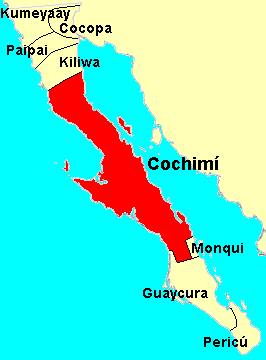
Early Baja Native Groups
At time of First Contact
(But what about before this?)
At the time of first contact with the peoples of what is now Baja California there were three linguistic groups of people. The Guaycura and Pericu who inhabited the southern quarter of Baja from about Loreto south. The Cochimi who lived in the central half of the peninsula from Loreto to about El Rosario. The remaining northern quarter was inhabited by a grouping of tribes with a common southern California Yuman language. These three language groups were distinctly different with no common word roots or groupings. This barrier to communication was reinforced by warring and territorial scuffles between groups and was witnessed by the Jesuit padres.
When the Jesuit padres made contact with the Cochimi there were times when the padres came across the rock art in the mountains. When the padres asked the Cochimi whether they made the paintings. They were told that “No, these paintings were here before we came”. In any subsequent discussions that involved reference to the great murals, the answer was always the same. . . Some group of people that lived in central Baja made the art before the Cochimi arrived on the scene. There was always reference also to the thought that they must have been giants. This I‘m sure, being surmised by the Cochimi from the height of some of the paintings above the nearby ground level.
On other topics of where the Cochimi originated from and how long they had been here in Central Baja, the padres could get nothing other than it was told in traditional stories and dances that the Cochimi originally “came out of the north a long long time ago”. The Cochimi language and concepts of time and history were just not clearly defined in their culture.
So, when was it that the Cochimi came to central Baja? . . . Maybe the best answer to that question, gentle readers, is still . . .”a long, long time ago”
However. . . I have an idea of timing based on the styles of rock art I’ve seen in various places. I believe that in considering the very thin slice that I have made on the art of central Baja, there are two, very distinct art styles present in central Baja and, if you observe the different levels of degradation of samples of the art, you cant help but conclude that they are from different ages. Also, being very much an amateur anthropologist I don’t possess the skills or training to make a justified treatise on the subject. . . (hedging my bets again!)
Harry Crosby feels that the great murals in the mountains of central Baja were painted by those that came before the Cochimi. The art at the San Borjitas cave site northwest of Mulege is in the great mural style and some of the paint from that site has been carbon dated to about 7,500 years before present. Enrique Hambleton talks of art in this area that is carbon dated to 9,200 years before present. This then, would put the Cochimi in the same area some time after that. That is if you adhere to the principal that one group will displace, or otherwise follow, the other. I suppose it is possible that the Cochimi and the Ancients co-inhabited the central part of the peninsula at the same time. This could put the earliest appearance of the Cochimi clans much earlier that currently supposed.
